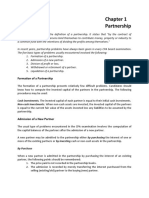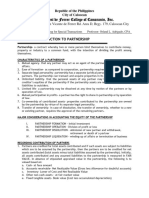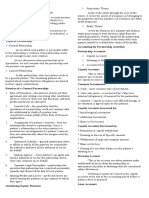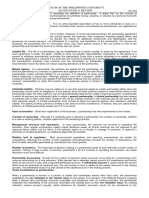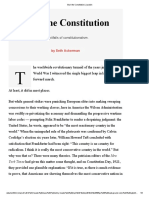0 ratings0% found this document useful (0 votes)
44 viewsACC 311 - Chapter 1 Partnership
ACC 311 - Chapter 1 Partnership
Uploaded by
Alyssa GuinoThe document discusses methods for dividing partnership profits and losses. It outlines several methods including dividing equally, using arbitrary ratios, capital contribution ratios, interest on capital balances, salaries, bonuses, and a combination of these methods. The partnership agreement takes precedence and specifies the agreed upon method. If no method is specified, profits and losses are divided according to capital contributions. When admitting a new partner, the bonus method records the fair market value of assets contributed and grants a partnership interest. Profits or losses may be realized depending on if the interest granted is higher or lower than the assets' value.
Copyright:
© All Rights Reserved
Available Formats
Download as PDF, TXT or read online from Scribd
ACC 311 - Chapter 1 Partnership
ACC 311 - Chapter 1 Partnership
Uploaded by
Alyssa Guino0 ratings0% found this document useful (0 votes)
44 views4 pagesThe document discusses methods for dividing partnership profits and losses. It outlines several methods including dividing equally, using arbitrary ratios, capital contribution ratios, interest on capital balances, salaries, bonuses, and a combination of these methods. The partnership agreement takes precedence and specifies the agreed upon method. If no method is specified, profits and losses are divided according to capital contributions. When admitting a new partner, the bonus method records the fair market value of assets contributed and grants a partnership interest. Profits or losses may be realized depending on if the interest granted is higher or lower than the assets' value.
Original Title
ACC 311_Chapter 1 Partnership
Copyright
© © All Rights Reserved
Available Formats
PDF, TXT or read online from Scribd
Share this document
Did you find this document useful?
Is this content inappropriate?
The document discusses methods for dividing partnership profits and losses. It outlines several methods including dividing equally, using arbitrary ratios, capital contribution ratios, interest on capital balances, salaries, bonuses, and a combination of these methods. The partnership agreement takes precedence and specifies the agreed upon method. If no method is specified, profits and losses are divided according to capital contributions. When admitting a new partner, the bonus method records the fair market value of assets contributed and grants a partnership interest. Profits or losses may be realized depending on if the interest granted is higher or lower than the assets' value.
Copyright:
© All Rights Reserved
Available Formats
Download as PDF, TXT or read online from Scribd
Download as pdf or txt
0 ratings0% found this document useful (0 votes)
44 views4 pagesACC 311 - Chapter 1 Partnership
ACC 311 - Chapter 1 Partnership
Uploaded by
Alyssa GuinoThe document discusses methods for dividing partnership profits and losses. It outlines several methods including dividing equally, using arbitrary ratios, capital contribution ratios, interest on capital balances, salaries, bonuses, and a combination of these methods. The partnership agreement takes precedence and specifies the agreed upon method. If no method is specified, profits and losses are divided according to capital contributions. When admitting a new partner, the bonus method records the fair market value of assets contributed and grants a partnership interest. Profits or losses may be realized depending on if the interest granted is higher or lower than the assets' value.
Copyright:
© All Rights Reserved
Available Formats
Download as PDF, TXT or read online from Scribd
Download as pdf or txt
You are on page 1of 4
CHAPTER 1: PARTNERSHIP III.
DIVISION OF PROFITS AND LOSSES
I. INTRODUCTION As a rule, profits and losses are allocated based
on agreement.
A PARTNERSHIP is defined as an
association of two or more persons who contribute Methods - Various methods exist for the
money, property or industry to a common fund DIVISION OF PARTNERSHIP PROFITS AND
with the intention of dividing the profits among LOSSES including the following:
themselves. 1. Equally
Accounting for partnerships should comply 2. Arbitrary ratio
with the legal requirements as set forth by the 3. Capital contribution ratio:
Partnership Law as well as complying with the a. Original Capital or initial investment
partnership agreement itself. b. Beginning Capital of each year
C. Average Capital
II. PARTNERSHIP FORMATION AND CAPITAL d. Ending Capital of each year
ACCOUNTS 4. Interest on capital balance and/or loan
balances and the balance on agreed ratio,
All assets contributed to the partnership 5. Salaries to partners and the balance on
are recorded by the partnership at their agreed agreed ratio,
values (or fair market values, in the absence of 6. Bonus to partners and the balance on
agreed values). agreed ratio,
All liabilities that the partnership a. Bonus as an "expense" in computing the
assumes are recorded at their net present bonus amount. Here, bonus is computed
values. Thus, if a partner contributes a noncash based on net income after bonus.
asset to the partnership (e.g. land or equipment b. Bonus as a distribution of profit. Here,
subject to mortgage), the Contributing partner's the bonus is computed based on net
capital account is credited for the agreed value income before deducting the bonus.
(or fair values) of the noncash asset less the 7. Interest on capitals and/or loan balances,
mortgage assumed by the partnership. salaries to partners, and bonus to partner and
The capital account is an equity account the balance on agreed ratio.
similar to the shareholders' equity accounts in a The method of division to be used in any
corporation. It is used to account for permanent given situation is generally the method
withdrawals and additional contributions. specified in the partnership agreement.
Other important accounts include a This agreement must always be consulted first
drawing account and loans to or from partners. since it is legally binding on the partners.
The drawing account is used to account If no profit and loss sharing arrangement
for net income or loss and personal or normal is specified in the partnership agreement, the
withdrawals, i.e., share against net income. It is partnership requires that profits and losses be
closed at the end of the period into the capital shared according to capital contribution.
account. Capital contribution should be
Loan accounts are set up for amounts interpreted to be original capital/beginning
intended as loans, rather than as additional capital capital of each year in the absence of original
investments. In liquidation proceedings, a loan to capital; similarly, if the agreement specifies
or from a partner is in essence treated as an how profits are to be shared but is silent as to
increase or decrease in a partner's capital account. losses, losses are to be shared in the same
manner as profits.
Notice that the profit and loss sharing ratio Total capital equals the book value of the
is totally independent of the partners' net assets prior to admittance of the new partner,
ownership interests. Thus, two partners may plus the FMV of the assets contributed by the new
have ownership interests of 70% and 30% but partner.
share profits and losses equally. A difference between the FMV of the
assets contributed and the interest granted to
IV. DISSOLUTION the new partner results in the RECOGNITION of
a BONUS.
A. Admission of a New Partner
a. No bonus recognized - When an incoming
A new partner may be admitted to the partner's capital account (ownership
partnership by purchasing the interest of one or interest) is to be equal to his purchase
more of the existing partners or by contributing price, the partnership books merely debit
cash or other assets (i.e., investment of cash or other assets and credit capital.
additional capital). These two situations are b. Bonus granted to the old partners - When
discussed below. the FMV of the assets contributed by an
incoming partner exceeds the amount of
1. Purchase of interest - When a new partner ownership interest to be credited to his capital
enters the partnership by purchasing the account, the old partners recognize a bonus
interest of an existing partner, the price paid equal to this excess.
for that interest is irrelevant to the This bonus is allocated on the basis of the
partnership accounting records because it is same ratio used for income allocation
a private or personal transaction between (unless otherwise specified in the partnership
the buyer and seller. The assets and agreement). Recording involves crediting the old
liabilities of the partnership are not affected. partners' capital accounts by the allocated
The capital account of the new partner is amounts.
recorded by merely reclassifying the capital c. Bonus granted to new partner - An incoming
account of the old partner. partner may contribute assets having a FMV
smaller than the partnership interest granted
2. Admission by Investment of Additional to that new partner.
Assets - A new partner may be granted an
interest in the partnership in exchange for Similarly, the new partner may not contribute
contributed assets and/or goodwill (e.g., any assets at all. The incoming partner is
business expertise, an established clientele, therefore presumed to contribute an intangible
etc.). The admission of the new partner and asset, such as managerial expertise or personal
contribution of assets may be recorded on business reputation. In this case, a bonus is
the basis of the bonus method. granted to the NEW partner, and the capital
accounts of the OLD partners are reduced on
*Bonus method - This method is based upon the the basis of their profit and loss ratio.
historical cost principle.
*Goodwill method. In PFRS No. 3, goodwill
Admittance of a new partner involves represents the excess of the cost of the business
debiting cash or other assets for the FMV of the combination OVER the fair value of the
assets contributed and crediting the new partner's identifiable net assets obtained.
capital for the agreed (i.e., purchased)
percentage of total capital. Therefore, the standard provides that
goodwill attaches only to a business as a whole
and is recognized only when a business is
acquired. This provision of PFRS No. 3 outlawed 1. Selling of an interest to an outsider. This is
the use of the goodwill method in partnership similar to admission by purchase.
accounting, particularly admission and retirement 2. Selling of an interest to an existing partner. The
of a partner because there is no business involved. interest of the retiring partner will be purchased
The term "business" is defined in the Appendix A with the personal assets of existing partners rather
of PFRS No. 3 as: than with the assets of the partnership.
An integrated set of activities and assets 3. Selling of an interest to the
conducted and managed for the purpose of partnership/payment from partnership fund.
providing: Under this approach, the withdrawal of a partner
maybe treated as:
(a) a return to investor, or
(b) lower costs or other economic benefits directly a. Payment at book value
and proportionately to policyholders or b. Payment at less than book value- bonus method
participants. c. Payment at more than book value - bonus
method
A business generally consists of inputs,
processes applied to those inputs, and resulting C. Incorporation of a Partnership
outputs that are, or will be used to generate
revenues. If goodwill is present in a transferred For a variety of reasons, including legal and/or tax
set of activities and assets, the transferred set reasons, the partners of a partnership may choose
shall be presumed to be a business. to incorporate.
B. Withdrawal of a Partner Two approaches of opening the corporate books
are in general use.
Admission of a new partner is not the only manner
by which a partnership can undergo a change in One is to retain the books of the partnership and
composition. Over the life of any partnership, to record all assets and liabilities at fair market
partners may leave the organization. Thus, some value concomitant with the closing of the partners'
method of establishing an equitable settlement of capital accounts and the opening of a Common
the withdrawing partner's interest in the business Stock account.
property is necessary.
The other approach is to close out the partnership
For a partner to withdraw or retire from the books completely and to open a new set of books
partnership, the total interest of a partner should for the corporation. In this case, the fair market
be properly determined which includes the values are used as the basis for recording all
following: assets and liabilities with the balancing amount
credited to Common Stock. Occasionally,
1. Share in the profit and loss of the partnership. additional cash or other assets may be invested in
2. Adjustments in assets and liabilities to reflect the corporation.
fair market values.
3. Loans to and from partnership. V. LIQUIDATION
4. Drawing accounts, and
5. Capital interest / accounts. Liquidation is the process of converting
partnership assets into cash and distributing the
Withdrawal or retirement from the partnership cash to creditors and partners.
may either be:
Frequently, the sale of assets will not provide
sufficient cash to pay both creditors and partners. Therefore, under this so-called right of offset
doctrine, a partner's loan to the partnership will
The creditors have priority on any distribution. have distribution priority only to the extent it
exceeds a debit balance in the partner's capital
The basic rule is that no distribution is made to account.
any partner until all possible losses and liquidation
expenses have been paid or provided for. An B. Installment Distributions - The
individual prematurely distributing cash to a liquidation of a partnership may take place over a
partner whose capital account later shows a deficit period of several months.
may be held personally liable if the insolvent
partner is unable to repay such a distribution. Installment distributions may be made to partners
on the basis of a Schedule of Safe Payments or
The proceeds of a liquidation may be distributed in Cash Priority Program, in conjunction with a
a lump sum after all assets have been sold and all Liquidation Schedule similar to the one used for
creditors satisfied, or the proceeds may be lump sum liquidations.
distributed to partners in installments as excess
cash becomes available. The Schedule of Safe Payments takes a
conservative approach to the distribution by
A. Lump Sum Distribution - The first step in assuming that noncash assets are worthless; thus,
the liquidation process is to sell all noncash assets distribution may be made to partners on the basis
and allocate the resulting gain or loss to the capital of the value of partnership assets, until the assets
accounts of the partners in accordance with their are sold.
profit and loss sharing ratio.
The second step is to satisfy the liabilities owing to
creditors other than partners.
The third step is to satisfy liabilities owing to
partners other than for capital and profits.
The final step is to distribute any cash remaining
to the partners for capital and finally for profits.
Any deficiency (i.e., debit balance) in a solvent
partner's capital will require that partner to
contribute cash equal to the debit balance.
If the deficient partner is insolvent, the debit
balance must be absorbed by the remaining
partners (usually in accordance with their profit
and loss sharing ratio).
Note, however, that in order to achieve an
equitable distribution, a partner's loan to the
partnership will first be used to offset a debit
balance in his capital account.
You might also like
- ISO 5832-11 2014 (E) Implants For Surgery - Metallic Materials - Part 11 Wrought Titanium 6-Aluminium 7-Niobium Alloy PDFDocument10 pagesISO 5832-11 2014 (E) Implants For Surgery - Metallic Materials - Part 11 Wrought Titanium 6-Aluminium 7-Niobium Alloy PDFSunny PanwarNo ratings yet
- Practical Accounting 2: Theory & Practice Advance Accounting Partnership - Formation & AdmissionDocument56 pagesPractical Accounting 2: Theory & Practice Advance Accounting Partnership - Formation & AdmissionGwen Cabarse Pansoy100% (1)
- Partnership: Formation of A PartnershipDocument70 pagesPartnership: Formation of A PartnershipWe W100% (1)
- Reviewer in Partnership PDF FreeDocument120 pagesReviewer in Partnership PDF Free잔잔No ratings yet
- Reviewer in PartnershipDocument121 pagesReviewer in PartnershipGlizette SamaniegoNo ratings yet
- Chapter 1: PartnershipDocument121 pagesChapter 1: PartnershipGab IgnacioNo ratings yet
- PDF 1pdfsam01 Partnership Formation Amp Admission of A Partnerxx 1pdfDocument57 pagesPDF 1pdfsam01 Partnership Formation Amp Admission of A Partnerxx 1pdflinkin soyNo ratings yet
- Acc 9 TestbankDocument143 pagesAcc 9 TestbankPaula de Torres100% (3)
- 01a Partnership Formation & Admission of A PartnerxxDocument73 pages01a Partnership Formation & Admission of A PartnerxxAnaliza OndoyNo ratings yet
- 1 - PDFsam - 01 Partnership Formation & Admission of A Partnerxx PDFDocument43 pages1 - PDFsam - 01 Partnership Formation & Admission of A Partnerxx PDFnash67% (3)
- Practical Accounting 2: Theory & Practice Advance Accounting Partnership - Formation & AdmissionDocument46 pagesPractical Accounting 2: Theory & Practice Advance Accounting Partnership - Formation & AdmissionKeith Anthony AmorNo ratings yet
- 2 Partnership Dissolution 0 Liquidation 2022Document16 pages2 Partnership Dissolution 0 Liquidation 2022Kimberly IgnacioNo ratings yet
- Advanced Financial Accounting and ReportingDocument15 pagesAdvanced Financial Accounting and ReportingAcain RolienNo ratings yet
- W1 Partnership AccountingDocument11 pagesW1 Partnership AccountingChristine Joy MondaNo ratings yet
- W1 Partnership AccountingDocument8 pagesW1 Partnership AccountingChristine Joy MondaNo ratings yet
- CCCSPECIALIZEDTRANSACTIONSLECTURE1 Partnersip Oct 32023Document2 pagesCCCSPECIALIZEDTRANSACTIONSLECTURE1 Partnersip Oct 32023EljayNo ratings yet
- Notes AstDocument19 pagesNotes AstMaria DubloisNo ratings yet
- ACC 311 - Chapter 1 PartnershipDocument6 pagesACC 311 - Chapter 1 PartnershipMark Laurence Sanchez100% (1)
- Partnerships Lecture Notes Partnership Formation and OperationDocument3 pagesPartnerships Lecture Notes Partnership Formation and OperationJessalyn CilotNo ratings yet
- Partnership Dissolution: Liability of Incoming Partner For Existing Obligations of The PartnershipDocument28 pagesPartnership Dissolution: Liability of Incoming Partner For Existing Obligations of The PartnershipChristine SalvadorNo ratings yet
- AdFAR.701 - Partnership Accounting - OnlineDocument6 pagesAdFAR.701 - Partnership Accounting - OnlineMikaela Lapuz Salvador100% (2)
- Chapter 1 - PartnershipDocument18 pagesChapter 1 - PartnershipFrancisco PradoNo ratings yet
- PARTNESHIPDocument6 pagesPARTNESHIPJustine FloresNo ratings yet
- Chapter 6 (Installment Sales)Document3 pagesChapter 6 (Installment Sales)Wynne KeirazillaNo ratings yet
- Lesson 1. Introduction To PartnershipDocument4 pagesLesson 1. Introduction To Partnershipangelinelucastoquero548No ratings yet
- Partnership Accounting Table of Contents: Partnership Formation, Operation & DissolutionDocument18 pagesPartnership Accounting Table of Contents: Partnership Formation, Operation & DissolutionGuinevereNo ratings yet
- Partnership Ex1Document10 pagesPartnership Ex1Queenel MabbayadNo ratings yet
- Part II Partnerhsip CorporationDocument101 pagesPart II Partnerhsip CorporationKhrestine ElejidoNo ratings yet
- Chapter 11 - Notes - 15thDocument6 pagesChapter 11 - Notes - 15thnishit patelNo ratings yet
- Part II Partnerhsip Corporation FAR PDFDocument101 pagesPart II Partnerhsip Corporation FAR PDFMary Joy Albandia100% (1)
- 1 Partnership FormationDocument10 pages1 Partnership FormationtheyaquitilNo ratings yet
- BAC 112 Midterm Examination With QuestionsDocument11 pagesBAC 112 Midterm Examination With Questionsjanus lopezNo ratings yet
- Theory Notes Part IDocument31 pagesTheory Notes Part ISuraj PatelNo ratings yet
- PARTNERSHIPDocument84 pagesPARTNERSHIPJohn Rey LabasanNo ratings yet
- AFAR - Partnership OperationsDocument3 pagesAFAR - Partnership OperationsCleofe Mae Piñero AseñasNo ratings yet
- Afar NotesDocument6 pagesAfar NotesGio BurburanNo ratings yet
- 1partnership Formation - HandoutsDocument2 pages1partnership Formation - HandoutsJohn Lloyd GalloNo ratings yet
- M1 - Partnership FormationDocument11 pagesM1 - Partnership FormationJhay MenesesNo ratings yet
- PACOADocument4 pagesPACOA2023309773No ratings yet
- 1 - Partnership ReviewDocument6 pages1 - Partnership ReviewTherese Anne VillaricoNo ratings yet
- CAC AFAR 1.0 Partnership Accounting Rev. 1 1Document7 pagesCAC AFAR 1.0 Partnership Accounting Rev. 1 1dedelalapozNo ratings yet
- PArtDocument6 pagesPArtMay DabuNo ratings yet
- 3 - Partnership DissolutionDocument6 pages3 - Partnership DissolutionAangela Del Rosario CorpuzNo ratings yet
- PARTNERSHIP (Wild)Document5 pagesPARTNERSHIP (Wild)geronimoayna100% (1)
- 2 - Partnership OperationsDocument6 pages2 - Partnership OperationsAangela Del Rosario CorpuzNo ratings yet
- Partnership Review Mats Lpu No AnswerDocument13 pagesPartnership Review Mats Lpu No Answerjames VillanuevaNo ratings yet
- AFAR 01 - Partnership AccountingDocument7 pagesAFAR 01 - Partnership AccountingcheoreciNo ratings yet
- Partnership DissolutionDocument5 pagesPartnership Dissolutionaj7939408No ratings yet
- 1 Partnership FODLDocument5 pages1 Partnership FODLMarianne PenoniaNo ratings yet
- AFAR 03 Partnership DissolutionDocument2 pagesAFAR 03 Partnership DissolutionArden LlantoNo ratings yet
- 1 Partnership ReviewDocument5 pages1 Partnership Reviewlisa jugan100% (1)
- Partnership Accounting NotesDocument5 pagesPartnership Accounting NotesHayes Hare100% (2)
- Combinepdf PDFDocument189 pagesCombinepdf PDFom sharmaNo ratings yet
- Partnership FormationDocument3 pagesPartnership Formationromerodriguez32No ratings yet
- Afar Concept Review Notes Part 1Document13 pagesAfar Concept Review Notes Part 1Alexis SosingNo ratings yet
- Chapter 1 - Part 1Document2 pagesChapter 1 - Part 1clarizaNo ratings yet
- Accounting For PartnershipDocument11 pagesAccounting For PartnershipgabNo ratings yet
- Accspec 1Document2 pagesAccspec 1Aye ChavezNo ratings yet
- Solution Manual: To AccompanyDocument60 pagesSolution Manual: To AccompanyGEORGINA KINIKANo ratings yet
- Textbook of Urgent Care Management: Chapter 46, Urgent Care Center FinancingFrom EverandTextbook of Urgent Care Management: Chapter 46, Urgent Care Center FinancingNo ratings yet
- Employer Need To Scan/prepare in Softcopy The Below DocumentsDocument4 pagesEmployer Need To Scan/prepare in Softcopy The Below DocumentsYuanng Mey YuanNo ratings yet
- Westlaw Edge - List of 191 References For Valenzuela Cynthia ADocument16 pagesWestlaw Edge - List of 191 References For Valenzuela Cynthia ASPQR STRMRNo ratings yet
- Burn The ConstitutionDocument6 pagesBurn The ConstitutionhafeezjamaliNo ratings yet
- Mongolian TögrögDocument6 pagesMongolian Tögrögphilip shternNo ratings yet
- Prayer Ministry PlanDocument11 pagesPrayer Ministry PlanEzekiel Kobina100% (1)
- Fundamental Analysis of Company XYZDocument5 pagesFundamental Analysis of Company XYZsk6813339No ratings yet
- Motq200524110023 79.4.9Document1 pageMotq200524110023 79.4.9buyinsurance9697No ratings yet
- PSD2 GlossaryDocument3 pagesPSD2 Glossarygostq1No ratings yet
- 70 DLR (HD) 303-Aleya - Vs - State - and - Ors - 20022018 - BDHCBDHC20182307181401103COM957349Document10 pages70 DLR (HD) 303-Aleya - Vs - State - and - Ors - 20022018 - BDHCBDHC20182307181401103COM957349Mehmud MehmudNo ratings yet
- Law of ContactDocument17 pagesLaw of Contactridom.hossain.5No ratings yet
- Annex 17 Subcontractor Warehouse Management RequirementDocument2 pagesAnnex 17 Subcontractor Warehouse Management RequirementHAWLITUNo ratings yet
- Branding and Marking For GranteesDocument15 pagesBranding and Marking For GranteesJhonNagaNo ratings yet
- Freestyle BibleDocument22 pagesFreestyle BiblePratik ThakareNo ratings yet
- People V RiveraDocument13 pagesPeople V RiveraBea DeLuis de TomasNo ratings yet
- Rocaberte V PP, 193 Scra 152Document3 pagesRocaberte V PP, 193 Scra 152Luna KimNo ratings yet
- Community Chiefs and Headmen Ordinance 2004Document11 pagesCommunity Chiefs and Headmen Ordinance 2004truthosis100% (1)
- Vapt Jntuh r18 CsDocument34 pagesVapt Jntuh r18 CsArjun100% (1)
- Arguementative Essay Final PaperDocument13 pagesArguementative Essay Final Paperapi-534256102No ratings yet
- Republic V Sayo - DigestDocument1 pageRepublic V Sayo - DigestWence IbabaoNo ratings yet
- Telegram 20797Document7 pagesTelegram 20797raushankumarkchaudhary829No ratings yet
- اردو کی گہرائی. Urdu book. Year 7 (PDFDrive)Document65 pagesاردو کی گہرائی. Urdu book. Year 7 (PDFDrive)VikasNo ratings yet
- Alexander II Reforms IBDocument4 pagesAlexander II Reforms IBFilip KlabanNo ratings yet
- US-Cuban TradeDocument13 pagesUS-Cuban TradeDeepti Tripathi100% (2)
- Lyxor MSCI Turkey UCITS ETF Acc EUR Stock Forecast Up To 56.238 EUR! - LTUR Stock Price Prediction, Long-Term & Short-Term SharDocument1 pageLyxor MSCI Turkey UCITS ETF Acc EUR Stock Forecast Up To 56.238 EUR! - LTUR Stock Price Prediction, Long-Term & Short-Term SharViktor VorskiNo ratings yet
- Overview of Indian Accounting Standards For SMEsDocument44 pagesOverview of Indian Accounting Standards For SMEsSamrat JonejaNo ratings yet
- Usaid Ict Assessment InsDocument139 pagesUsaid Ict Assessment InsbudimahNo ratings yet
- SHARP Essay: BLC CLASS 00-22 SSG Blevins. NathanielDocument3 pagesSHARP Essay: BLC CLASS 00-22 SSG Blevins. NathanielChris DickensNo ratings yet
- Unit Two General and Subsidiary Ledgers: AU Ethiopian Government Accounting 2019Document10 pagesUnit Two General and Subsidiary Ledgers: AU Ethiopian Government Accounting 2019TIZITAW MASRESHANo ratings yet
- Précis Writing: The Following Rules Are General Guidelines You Should Follow While Writing A PrécisDocument4 pagesPrécis Writing: The Following Rules Are General Guidelines You Should Follow While Writing A PrécisRameen WaseemNo ratings yet


